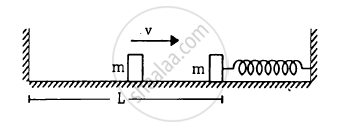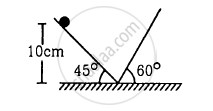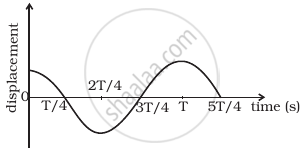Advertisements
Advertisements
प्रश्न
A uniform plate of mass M stays horizontally and symmetrically on two wheels rotating in opposite direction in Figure . The separation between the wheels is L. The friction coefficient between each wheel and the plate is μ. Find the time period of oscillation of the plate if it is slightly displaced along its length and released.

उत्तर
Let x be the displacement of the uniform plate towards left.
Therefore, the centre of gravity will also be displaced through displacement x.
At the displaced position,
R1 + R2 = mg
Taking moment about g, we get:
\[R_1 \left( \frac{L}{2} - x \right) = R_2 \left( \frac{L}{2} + x \right) = \left( Mg - R_1 \right) \left( \frac{L}{2} + x \right) . . . . \left( 1 \right)\]
\[ \therefore R_1 \left( \frac{L}{2} - x \right) = \left( Mg - R_1 \right) \left( \frac{L}{2} + x \right)\]
\[ \Rightarrow R_1 \frac{L}{2} - R_1 x = Mg\frac{L}{2} - R_1 x + Mgx - R_1 \frac{L}{2}\]
\[ \Rightarrow R_1 \frac{L}{2} + R_1 \frac{L}{2} = Mg\left( x + \frac{L}{2} \right)\]
\[ \Rightarrow R_1 \left( \frac{L}{2} + \frac{L}{2} \right) = Mg\left( \frac{2x + L}{2} \right)\]
\[ \Rightarrow R_1 L = Mg\left( 2x + L \right)\]
\[ \Rightarrow R_1 = Mg\frac{\left( L + 2x \right)}{2L}\]
\[\text { Now }, \]
\[ F_1 = \mu R_1 = \mu Mg\frac{\left( L + 2x \right)}{2L}\]
\[\text { Similarly }, \]
\[ F_2 = \mu R_2 = \mu Mg\frac{\left( L - 2x \right)}{2L}\]
\[\text { As } F_1 > F_2 , \text { we can write: }\]
\[ F_1 - F_2 = Ma = \left( 2\mu\frac{Mg}{L} \right)x\]
\[ \frac{a}{x} = 2\mu\frac{g}{L} = \omega^2 \]
\[ \Rightarrow \omega = \sqrt{\frac{2\mu g}{L}}\]
\[\text { Time period }\left( T \right)\text{ is given by }, \]
\[T = 2\pi\sqrt{\frac{L}{2\mu g}}\]
APPEARS IN
संबंधित प्रश्न
A copper metal cube has each side of length 1 m. The bottom edge of the cube is fixed and tangential force 4.2x108 N is applied to a top surface. Calculate the lateral displacement of the top surface if modulus of rigidity of copper is 14x1010 N/m2.
Which of the following example represent periodic motion?
An arrow released from a bow.
The length of the second’s pendulum in a clock is increased to 4 times its initial length. Calculate the number of oscillations completed by the new pendulum in one minute.
A particle executes simple harmonic motion with a frequency v. The frequency with which the kinetic energy oscillates is
A particle is fastened at the end of a string and is whirled in a vertical circle with the other end of the string being fixed. The motion of the particle is
A spring stores 5 J of energy when stretched by 25 cm. It is kept vertical with the lower end fixed. A block fastened to its other end is made to undergo small oscillations. If the block makes 5 oscillations each second what is the mass of the block?
A small block of mass m is kept on a bigger block of mass M which is attached to a vertical spring of spring constant k as shown in the figure. The system oscillates vertically. (a) Find the resultant force on the smaller block when it is displaced through a distance x above its equilibrium position. (b) Find the normal force on the smaller block at this position. When is this force smallest in magnitude? (c) What can be the maximum amplitude with which the two blocks may oscillate together?

The left block in figure moves at a speed v towards the right block placed in equilibrium. All collisions to take place are elastic and the surfaces are frictionless. Show that the motions of the two blocks are periodic. Find the time period of these periodic motions. Neglect the widths of the blocks.

Find the time period of the motion of the particle shown in figure . Neglect the small effect of the bend near the bottom.

A uniform disc of radius r is to be suspended through a small hole made in the disc. Find the minimum possible time period of the disc for small oscillations. What should be the distance of the hole from the centre for it to have minimum time period?
A body of mass 1 kg is mafe to oscillate on a spring of force constant 16 N/m. Calculate (a) Angular frequency, (b) Frequency of vibrations.
The period of oscillation of a body of mass m1 suspended from a light spring is T. When a body of mass m2 is tied to the first body and the system is made to oscillate, the period is 2T. Compare the masses m1 and m2
The maximum speed of a particle executing S.H.M. is 10 m/s and maximum acceleration is 31.4 m/s2. Its periodic time is ______
A simple pendulum is inside a spacecraft. What will be its periodic time?
Which of the following example represent periodic motion?
A hydrogen molecule rotating about its center of mass.
The equation of motion of a particle is x = a cos (αt)2. The motion is ______.
The displacement time graph of a particle executing S.H.M. is shown in figure. Which of the following statement is/are true?

- The force is zero at `t = (T)/4`.
- The acceleration is maximum at `t = (4T)/4`.
- The velocity is maximum at `t = T/4`.
- The P.E. is equal to K.E. of oscillation at `t = T/2`.
What are the two basic characteristics of a simple harmonic motion?
When a particle executes Simple Harmonic Motion, the nature of the graph of velocity as a function of displacement will be ______.
